Ellen and Jim Have a Blog, Too
We are two part-time academics. Ellen teaches in the English department and Jim in the IT program at George Mason University.


The Maze: a redemptive Christmas tale · 23 December 07
Dear Marianne,
Much to my surprize and enjoyment I found myself watching an Xmas ghost story last night: Ken Taylor’s The Maze, adapted from C. B. H. Kitchin’s short story, “The Maze.”
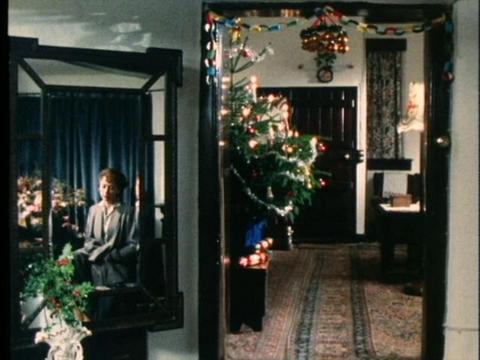
Catherine Frode (Francesca Annis) thinking about what is happening in The Maze (1985 Granada)
For 2 prevous Xmases a group of us on Women Writers through the Ages read ghost stories by women, & this year we’re reading May Sinclair’s gothic Uncanny Tales and watching the gothic tales gathered under the rubric Shades of Darkness. The Lady’s Maid’s Bell and Afterward have turned out to be excellent films; this 1985 Granada Maze (directed by Peter Hammond, producer June Wyndham-Davies) fits the common Xmas ghost story paradigm, except it’s Dickensian (redemptive), & the person helped is not a miser, but a woman whose child’s father is not her husband’s but her now dead lover’s.
That this ghost story is set around Xmas time is not surprizing; that the ghost’s purpose is benign not unique (think of Dickens’s Christmas Carol); that the individual treated with so much love is a cold mother and Brief Encounter type wife who did commit adultery is rare. This third film adaptation demonstrates the Shades of Darkness series does indeed sympathize with women from a point of view which enters into their lives as they perceive the experience.
It’s Christmas 1941. Catherine Frode (played by Francesca Annis), her husband, Arthur (James Bolam), & their daughter, Daisy (Sky Macaskill) have come to live in a large old house left to Catherine upon her mother’s death. The ghost of Fred Harston (played by Duncan Preston) begins to appear repeatedly in its beautiful erotic and labyrinthine garden maze:
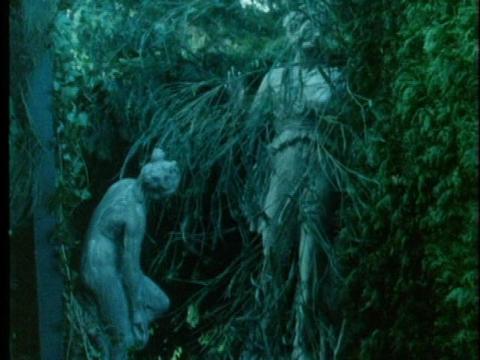
The maze with its statues (Granada 1985)
In this case the revenant, Fred, comes back from the dead to haunt Daisy because she is his biological daughter. As in The Lady’s Maid’s Bell, the ghost has a benign purpose: by coming to the child and getting the mother to come out into the garden maze with her, he enables the mother to throw off her distance from her child, tell her the truth about her parentage, and begin to love her. The mother had been alienated from, keeping her distance from her child by guilt and a need to keep Daisy’s full parentage hidden. What constitutes a happy ending in this story? Mother, daughter, and the husband (who suspects he is not the father of this child and is very bitter about this) leave the house and maze for a new life with the mother and daughter drawn close & loving by taking the memory of the ghost’s presence with them.
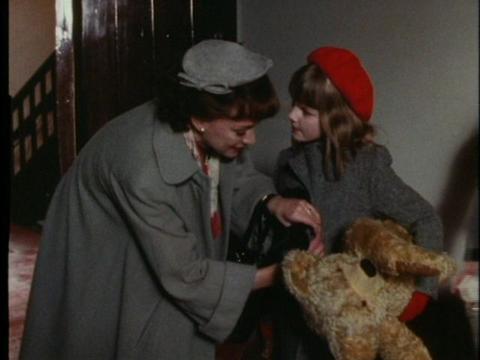
The story belongs to a type we had been discussing on WWTTA about a month ago when we read and discussed Alison Light’s Forever England and Nicola Beauman’s A Very Great Profession, books about women’s novels and memoirs in the 1st half of the 20th century: Taylor’s story line and the way the characters are dressed and interact is closely analogous to that of Brief Encounter. Annis’s outfits could have been those of Celia Johnson as Laura in the film: the determined non-overt sexuality, the femininity and middle-classness of these clothes signals a safe way of life for women dependent on repression; the husband, Arthur resembles the husband in Brief Encounter: non-sexy, the man who works all day in an office and reads his papers at night and lives according to a quiet dull but kindly routine. But unlike the Laura of the film, Catherine commits adultery, experiences an encounter of sexually fulfilling love.
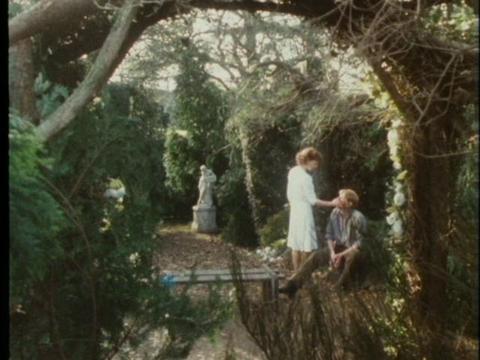
Catherine approaching Fred

Drawing close
Also unlike Laura (who famously met who played out most of her time with her yearned-for lover, Trevor Howard, in a dark anonymous train station), the relationship Catherine had with Fred began when they were children. When they were around 10, a cousin of Laura’s, Mervyn Barbet, had playfully married them during Christmas:
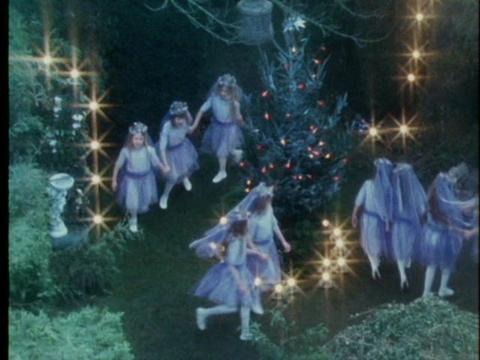
Though we are given to believe the children grew to love one another, and still did as young adults, Fred is working class and thus not suitable for Catherine to marry. She remembers that she married Arthur Frode at a time she felt her life had no meaning, and she could not think what to do with it, had nothing to look forward to. Fred had become her mother’s gardener, and some time after she married Arthur, one fall day (October 10th), she and Fred made love and she became pregnant. Here is the beautiful young man a decade ago:
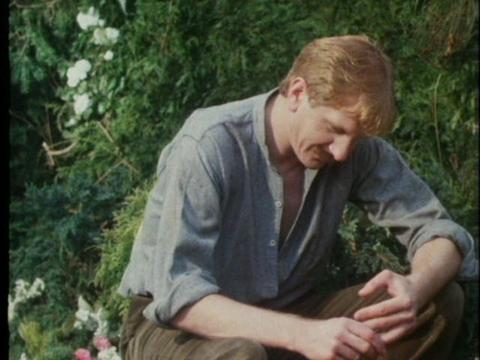
Then tragedy struck: the day Catherine gave birth to their child, he died falling from a tree (this reminds me of how the young husband died in Susan Hill’s In the Springtime of the Year). Catherine now has repeated nightmares remembering herself in labor and he dead:
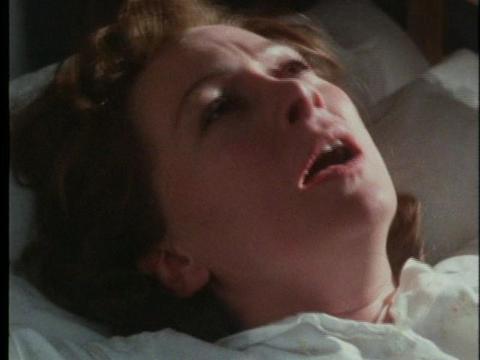
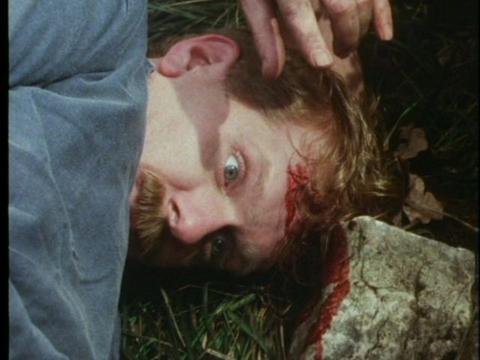
The role of Arthur is a thankless one as he is “merely” a very successful barrister, and as a personality made unattractive, dull, and (understandably even in the film) resentful, though he does not take his suspicions or frustrations out on the child or his wife. When her cousin, Mervyn Barbet (played by Philip Sayers) comes to visit for Christmas, we discover he is homosexual. The code language used: Mervyn is called “a Dorian Gray.” And therefore, Arthur dislikes him. Here they are in the garden disagreeing about the coming visit:
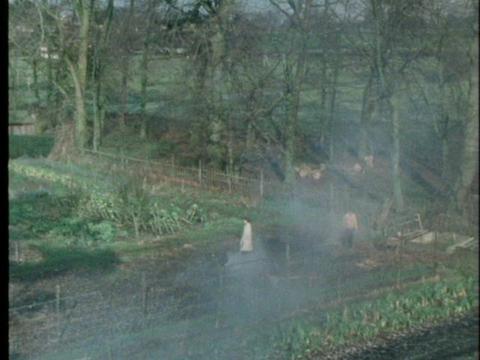
It’s suggested that Mervyn was also Fred’s lover. Though the atmosphere is very unlike that of Lawrence’s caretaker (Lady Chatterley’s Lover), and Fred appears to have been the one the others aggressed at, Fred does seem to have got around.
What’s remarkable is this wife and mother is not punished, but sympathized with—as Scrooge is sympathized with for typical male cruel capitalist deeds & a resulting lonely miser’s life.
Francesca Annis is continually photographed to emphasize her wistful elegant beauty:
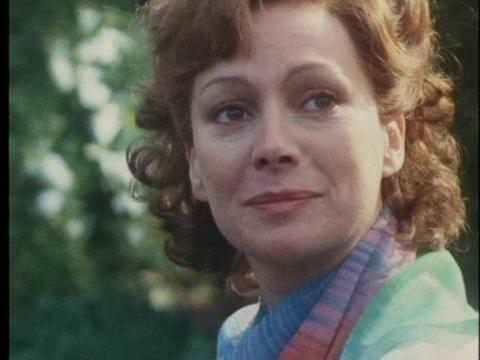
Catherine remembering gazing at Fred
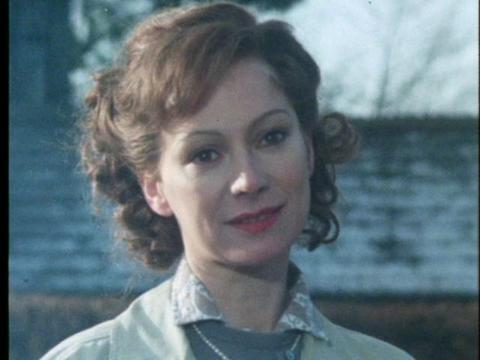
Catherine remembering her cousin, Mervyn, when they were children together
Annis’s most recent role is that of the aging widow, Lady Ludlow, in Heidi Thomas, Sue Birtwistle & Sue Conklin’s Cranford Chronicles; I remember her most notably as Mrs Gibson in the 2001 BBC Wives and Daughters.
Like The Lady’s Maid’s Bell & Afterward, this filmic story is also an effective mood piece. It follows the rhythms of a woman’s life. We see Catherine interacting with her housekeeper first: the housekeeper is to make the child’s meal while she goes to have her hair done; we see her interacting with the child: the mother tries to get the child to behave; when the mother goes off to have her hair done, the child runs off and hides and the mother becomes terrified she has been kidnaped:
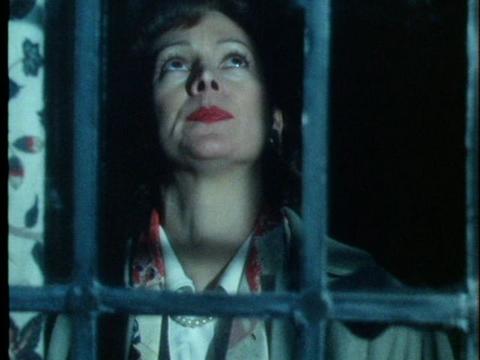
The mother in an archetypal window-prison scene, wondering if she should call the police who might ridicule her
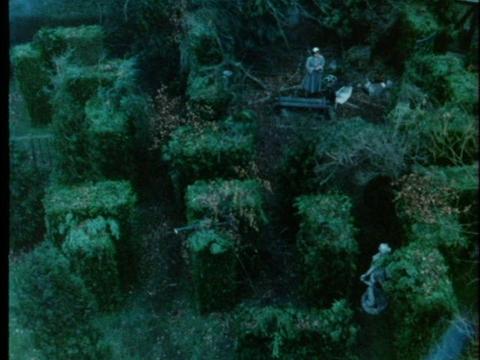
The mother seeking the apparently lost child
We see her eating with her husband eating, sewing next to him by the fireplace (this is pre-TV):
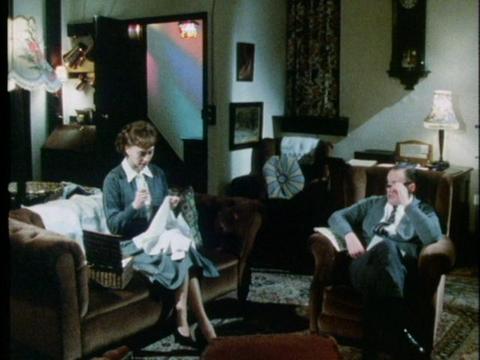
Sitting up by him in bed:
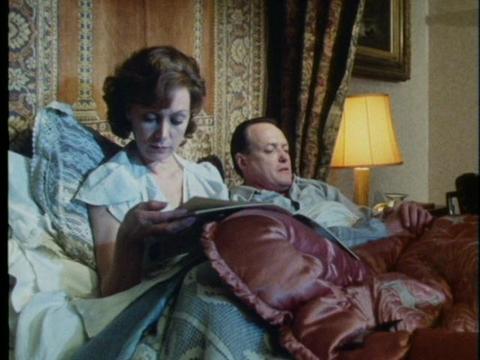
We see her joy when an old friend, Mervyn, comes to call:
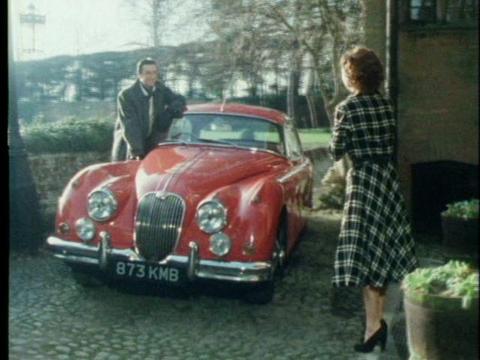
We see him talking with her daughter and the ubiquitous teddy bear:
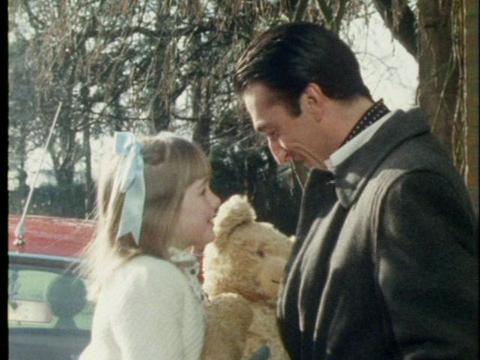
Memories of the past and dreams and nightmares are interwoven, and yet it’s all very quietly done, nothing overstated once again.
I only know of one ghost story beyond Dickens’s where the ghost attempts to be a redemptive figure: Margaret Oliphant’s “Lady Mary’s Story,” and there the ghost fails to retrieve time, turn over the results of the past, and alter the future. Admittedly this is a romantic-sentimental approach, but it’s one rarely applied to to soften the harsh realities of women’s choices and desires.
Such films are a gift, Marianne,
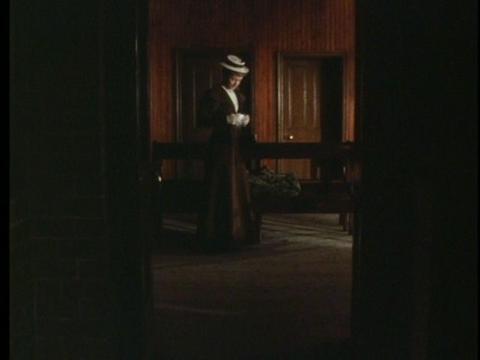
A still from Lady’s Maid’s Bell: Miss Hartley (Joanna David), travelling alone to a new job
Elinor
--
Posted by: Ellen
* * *
Comment
- P.S. In the original play by Noel Coward (from which the famous 1940s movie was adapted), the wife did consummate her affair with her lover.
E.M.
— Elinor Dec 24, 10:28am #
commenting closed for this article
